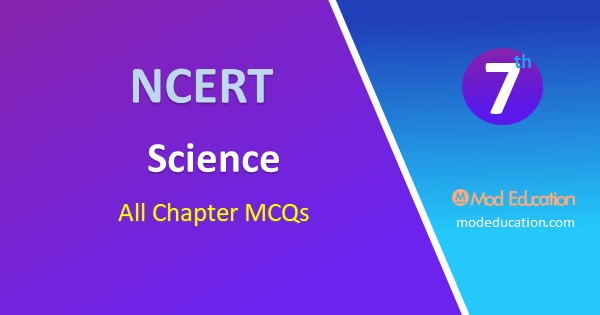MCQ Questions for Class 7 Science Chapter 9 : NCERT solutions for Class 7 Science MCQs Chapter 9 “Soil” with Answers PDF Free Download prepared here according to the latest CBSE syllabus and NCERT curriculum. Class 7 Science MCQs Multiple Choice Questions for all Chapter.

MCQ Questions for Class 7 Science Chapter 9 Soil with answer PDF
Q1. _ are soils in which more than half of the parent mineral matter is volcanic ash and appear very dark in colour.
(a) Desert soil
(b) Volcanic soil
(c) Alluvial soil
(d) Clayey soil
Answer: (b) Volcanic soil
Q2. Which one of the following is a step in the formation of soil?
(a) Earthquakes or volcanic eruptions
(b) Weathering of rocks
(c) Addition of humus
(d) All are involved in the formation of soil
Answer: (d) All are involved in the formation of soil
Q3. The rotten dead matter in the soil is called:
(a) organic matter
(b) sand
(c) humus
(d) silt
Answer: (a) organic matter
Q4. A well-developed soil profile is the result of:
(a) physical process
(b) chemical process
(c) organic process
(d) All of the above
Answer: (d) All of the above
Q5. In which horizon of soil minerals are found?
(a) A
(b) B
(c) C
(d) None of these
Answer: (b) B
Q6. Soil is formed from the parent rock material by a very slow and gradual process called:
(a) processing
(b) weathering
(c) breaking
(d) cutting
Answer: (b) weathering
Q7. Soil contains rock particle and_______.
(a) water and air
(b) water and plants
(c) minerals, organic matter, air and water
(d) water, air and plants
Answer: (c) minerals, organic matter, air and water
Q8. Which physical property of soil is important to us?
(a) Texture
(b) Water holding capacity
(c) Both of these
(d) None of these
Answer: (c) Both of these
Q9. The uppermost layer of earth’s crust, in which plants grow is:
(a) soil
(b) land
(c) water
(d) none of these
Answer: (b) land
Q10. Of the four distinct layers or sections of soil profile, organic matter is found in:
(a) top soil
(b) second layer from the top
(c) third layer from the top
(d) the bottom layer
Answer: (a) top soil
Q11. Which of the following type of soil will form a colloidal solution when suspended in water?
(a) Clay
(b) Silt
(c) Sand
(d) Gravel
Answer: (a) Clay
Q12. The uses of soil are:
(a) soil gives crop
(b) soil gives support to buildings
(c) toys can be made from soil
(d) all of these
Answer: (a) soil gives crop
Q13. The topmost soil:
(a) is soft
(b) is a porous layer
(c) can retain more water
(d) All of the above
Answer: (c) All of the above
Q14. Which factor influences soil formation?
(a) Climate
(b) Vegetation
(c) Parent rock
(d) All of these
Answer: (d) All of these
Q15. Soil is polluted by:
(a) air
(b) water
(c) polythene bags
(d) none of these
Answer: (d) none of these
Q16. Soil best suited for cultivation of wheat, rice and sugarcane is
(a) Alluvial soil
(b) Laterite soil
(c) Mountain soil
(d) None of these
Answer: (a) Alluvial soil
Q17. The proportion of sand, silt and clay in a soil sample determines
(a) structure
(b) texture
(c) nutrient potential
(d) fertility level
Answer: (b) texture
Q18. A vertical section through different layers of the soil is:
(a) horizons
(b) soil profile
(c) both (a) and (b)
(d) none of these
Answer: (c) both (a) and (b)
Q19. Humus refers to the:
(a) top most layer
(b) bottom layer
(c) rotting dead matter in soil
(d) None of these
Answer: (c) rotting dead matter in soil
Q20. The microorganisms present in the soil require moisture (water) and nutrients for growth and survival. Choose from the options below the habitat (place) where the soil has plenty of water and nutrients.
(a) Desert
(b) Forest
(c) Open field
(d) Cricket ground
Answer: (b) Forest
